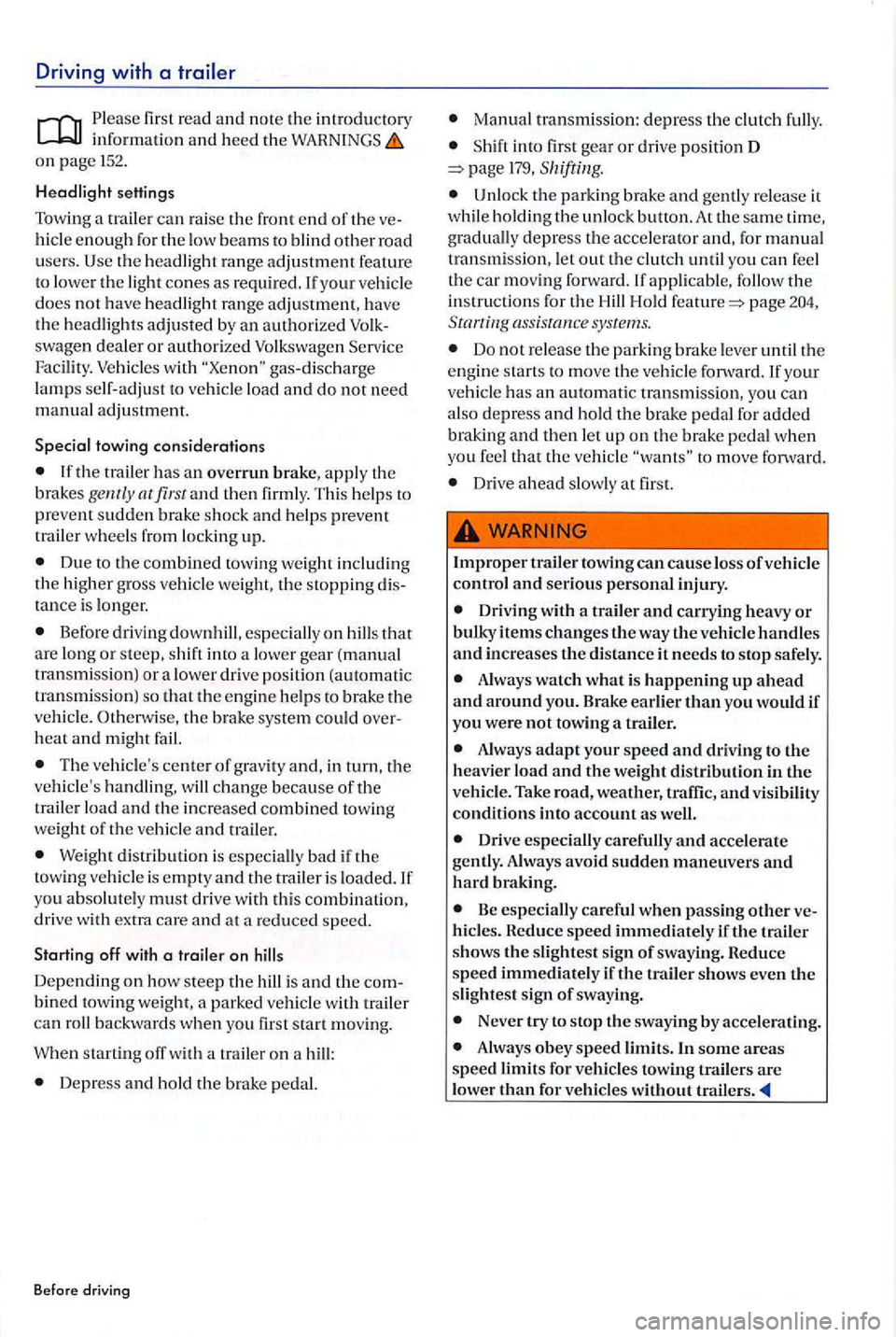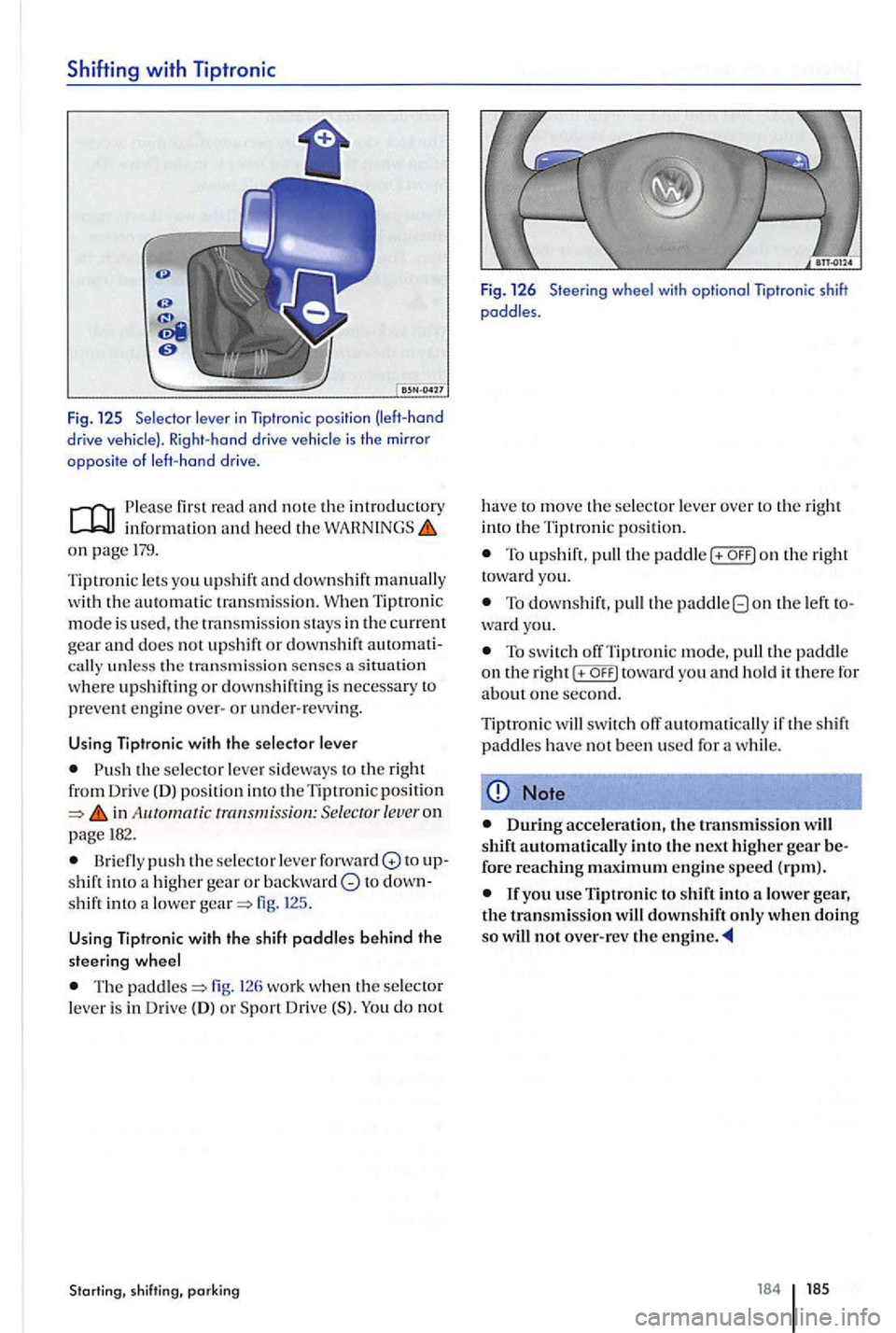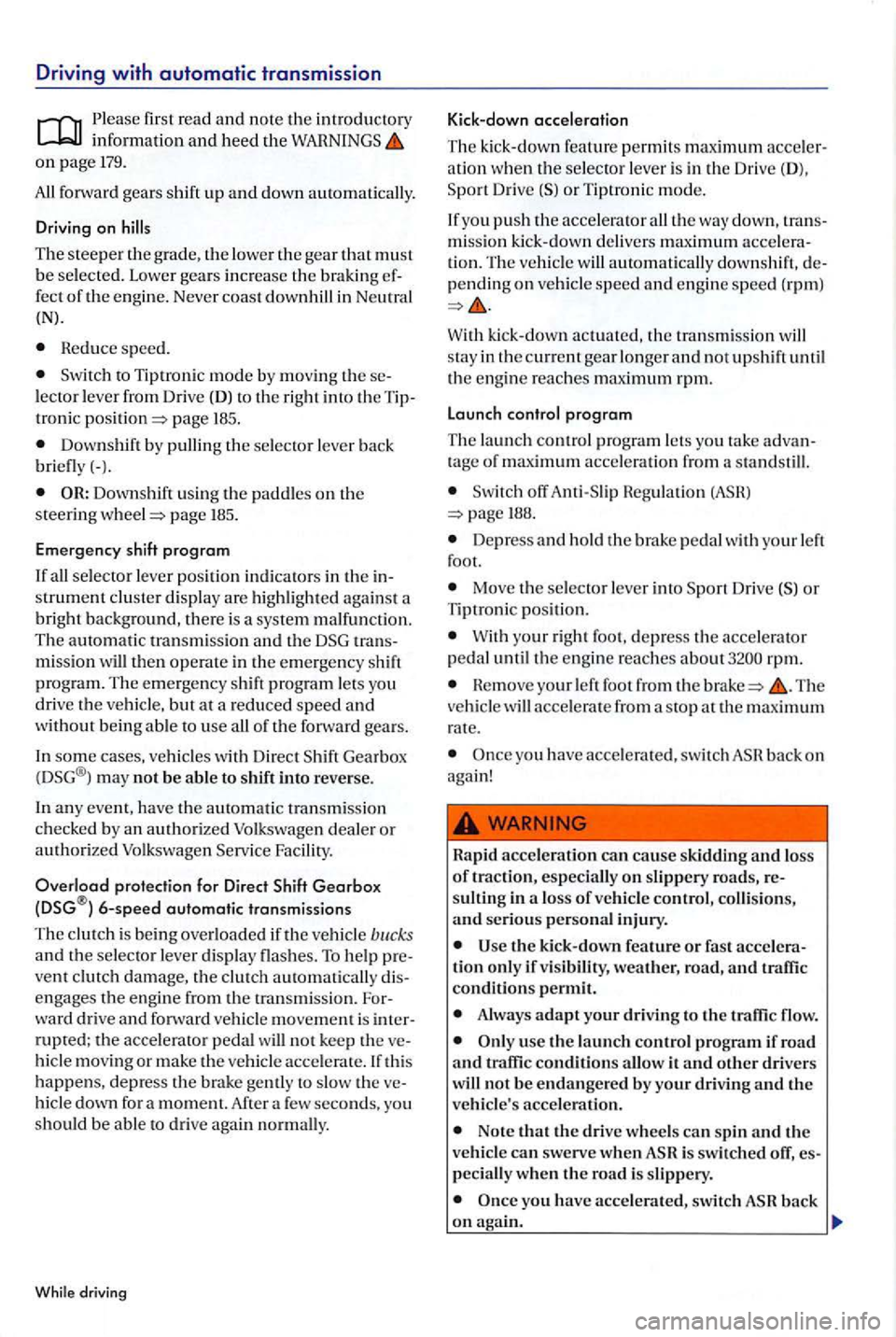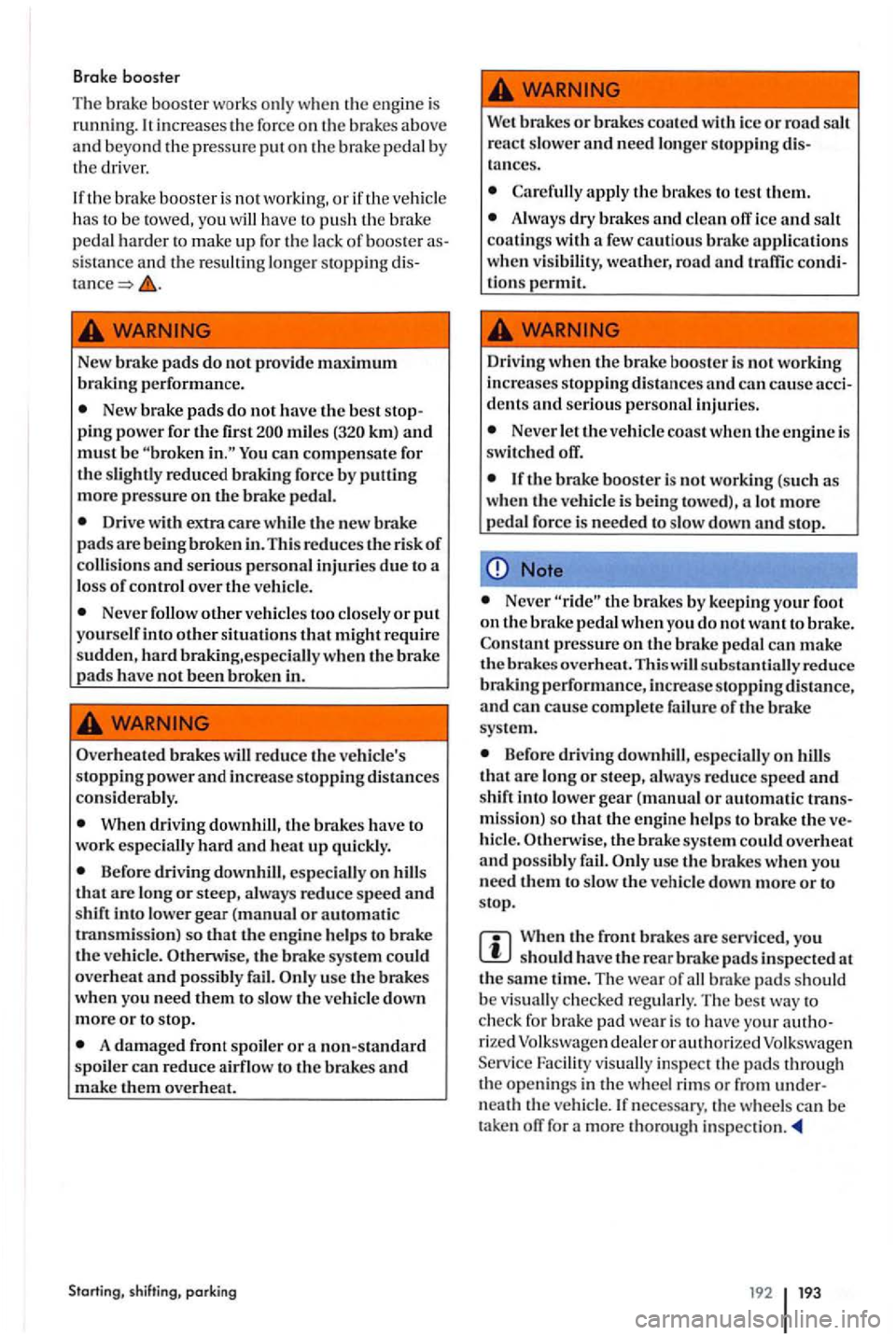2012 VOLKSWAGEN GOLF PLUS Automatic off
[x] Cancel search: Automatic offPage 157 of 541

Driving with a
Please fir st read and note the introductory
o n page 152.
Headlight settings
Towing a tra
ile r can ra ise the fron t end of th e ve
hicle enough fo r the low beam s to blind other road u sers. the headlight ra nge adjustment feature
to lower the light cones as req uired . your vehicle does not have headlight range adjustment, have
the headli gh ts adjusted by an authorized Volkswage n dealer or au th orized Volkswagen Serv ice Facility . Vehicles with gas-d ischa rge lamps self-adjus t to vehicle load an d do not need manual adjustme nt.
Special towing
considerations
Due to th e combined towing weig h t includin g the hi gh er gross vehicle weight, the stopping distance is longer .
Before driving downhill , especially on hills that
a re long or steep, shift in to a lower gea r (m anual
t ransmi ssion) or a lower drive position (automatic
t ra n smi ssion) so that the eng in e helps to brake th e vehicl e. Otherwise, the b rake system could ove rheat and might fail.
The ve hicle's center of grav ity and, i n
Weigh t dis tr ibutio n i s especially bad if the
tow ing veh icle is e mpty and the traile r i s loaded. If
you absolutely must d rive with this combination , drive with extra care an d at a reduced speed.
Starting off with a trail er on hills
Depend ing o n how steep the h ill is and the combined tow ing weig ht, a parked vehicle wi th trailer can roll backwards when yo u firs t sta rt mov ing.
When sta rti
ng off with a trailer on a hill :
Depress and ho ld the brake pedal.
Befo re driv ing
Ma nual transmiss io n : d epress th e clutch fully.
Shift into fir s t gear or drive posi t ion D page 179,
Unlock the par ki ng brake and release it
w hil e ho ld ing th e unl ock butto n.
page assistance systems.
Do not re lease th e parkin g bra ke leve r until the engine sta rt s to move th e vehicle fonvard. your veh icle has an automatic t ransmissio n, yo u can
also depress a nd ho ld the brake pedal for added b raking and then letup on th e brake pedal w hen
you feel th a t the vehicle to move fo rward.
Drive ahead slowly at first.
A lways watch what i s happening up a head
and a round you. Brake earlier than you would if yo u were not to wing a trailer.
Drive especially care full y and accel erate gently. Always avoid sudde n m an euvers and h ard braking.
Be especiall y care ful when p ass ing other hicles. Reduce speed immediate ly if t he trailer
s hows the s lightes t sig n of swayin g. Reduce speed immediatel y if the t ra ile r shows even the
slightest sig n of sway ing.
Neve r try to sto p th e swayin g by accelerating.
Page 176 of 541

hide key can be removed from the ig nition
sw itch only when th e tra nsmiss ion is in Park
locking and starting system: Starter button.
first read and no te th e in trod uctory inform ation and heed the on page 172.
The starter button can only be opera ted when an authorized vehicle key is in t h e vehicl e.
leaving the ve hicl e, the e lectronic stee rin g
co lumn lock is ac tiva te d when th e ign ition is switch ed off and the driver door is opened page201.
Switching the ignition on and off
Briefly press the s ta rt er button once w ithout opera ting th e brak e or clutch
Emergency start function
If n o authorized vehicle key is identifi ed in the pas
se nger compartment, use th e e merge ncy start functio n . A re lated message appears in the in stru ment cluster disp lay. This could be the case if th e
battery in th e ve hicl e key is wea k or discharged, for
e xample:
Hold the vehicle key to the righ t of the stee rin g
column trim immedi a te ly after press ing the star te r button fig .
T he ign ition automatically switc h es on.
Starting, shi fting, parking
Fig . Emerge ncy start function for vehicles with
Emergency shut-o ff
If the en g ine does no t sw itch off by bri efly pre ssing the s tart er bulton, emergen cy shut-off is neces
sary :
the starte r buuon twice withi n one
second o r once for more than two seconds=> in Stoppingtlleengineon page 177.
The moto r switch es off automatically.
Engine restart function
If no authorized vehi cle key is identi fied in the pas
se nger compartment after the engine has been
switc hed off, the e ng in e can b e res ta rted w it hin about 5 seconds. A message to this effect is sh own
in the di sp lay of th e in stru ment clu ster.
After the five seconds hav e passed, the en gin e ca n
no longer be starte d without an authorize d ve hicle
key in the passenger compartment.
Unintended vehicl e movement can ca use se
rious personal inju ry.
Do
__ e_n_v_is_e_s_t_a_rt_i_m __
17 4 175
Page 179 of 541

If the engine has been driven hard for long time, the engine co uld overheat when it is stopped. To reduce the risk of engine damage, le t the engine id le in for about 2 minutes before you switch ofT the ignition.
read and n o te the int rod uctory information and heed th e on page 172.
The immobilize r helps to pre vent the en g in e from bein g s tarted and driven w ith an unauthorized ve
hicle key.
Th ere is mi croc hip insid e the ve hicle key. T he chip deactivates the immobilize r automatically
w hen the ve hicl e key is inserted int o the ig nition swit ch .
The electron ic immobilizer is automatically acti
vated when the ve hicle key is pulle d out of the ig
niti on switch. ve hicles with the vehicle
key mus t be outsid e the page 41.
While driving
ve hicles wit h automatic transmi ssions,
the engine has been switched ofT, the radiator fan in the engi ne com partment may ke ep running for several minutes, or may start run
nin g afte r th e ve hicl e has been parke d for a w hile, even if th e ig nition is switch ed ofT a nd the ignition
key has been removed. The rad iator fan shuts off automatically when the en g ine has coole d down enough .
Th e e ng in e can there fore onl y be started with a correct ly coded genuine Volk swagen ve hicle key. ve hicle keys are availab le from authorized Volkswage n dea lers, authorized Volk swage n vice Fac ilities, and from certain independent repair facilit ies and locksmiths who a re qualified to m ake vehicle page 34.
I
fan unauthorize d ve hicle key is used, SAFE or Im mobiliz er active ! appears in the in strument clu ste r display. The ve hicl e cannot be operated w ith this key.
Using gen uine Volkswage n key s helps minimi ze the risk of malfu nctions .
Page 186 of 541

Shiftin g with Tipt ronic
Fig . 125 Selector lever in
Please first read and note the introductory info rmati on and heed the on page 179.
Tiptronic l ets you upshi ft and down shift manu ally
w ith the automatic tran smission. W hen Tiptronic
m ode is use d, the tran smi ssion stays in the current gear and does no t upshift or downshift
Push the selector leve r sid eways to the right
fro m Drive (D) po siti on int o theTiptronic position Selector lever o n page 182 .
push th e se lector lever for ward to to fig.
Using Tip tronic with the s hift paddles behind the
steering w heel
Th e fig. wo rk whe n the selector
lever is in Dri ve (D ) o r
shift paddles.
have to move the se lector leve r over to the right int o the Tiptronic positi on.
To upshift , pull th e paddle (+ o n the right to wa rd you.
To downsh ift, pull th e paddle o n th e le ft
T o switch offTiptronic m ode, pull the paddle on the rig ht( + OFF) towa rd yo u and hold it there for about one second.
Tiptron
ic will s wi tc h off a utomatically if the s hift paddles have not been used for
Note
During acceleration, the transmission will
shif t automatically into the next higher gea r fore reaching maximum en g in e speed (rpm).
184 1 85
Page 187 of 541

Driving with automatic transmission
Please fir st read and n ote the int rod uctory informatio n and heed th e WARN INGS on page 179.
All forwa rd gea rs shift up and down automatically.
Driving on
Th e steeper grade, lower the gea r that must be selec te d. Lowe r gea rs in crease the b raking ef
fect o f th e e ng ine. Neve r coast downhill in (N).
Heduce sp eed.
Switch to Tiptron ic mod e by m oving theselecto r l eve r fro m Drive (D) t o the rig ht into the Tipp age 185.
Dow nshift by pullin g th e selec to r l ever back briefly(-).
page 185.
Emergency shift
program
trans
m issio n will th en operate in th e em ergency shif t
p rogram. The emergency shift progra m lets you drive th e ve hicle, bu t at a re duced speed and w ithout bein g able to use all of th e forwa rd gears.
I n
som e cases, vehicles with Direct Gearbox (DSG® ) may not be able to shift into reverse.
I n
any event, have the automatic tra nsm iss ion checke d by an authorized Volkswage n dealer or authorized Volkswage n Service Facility.
O verload prot ection for Direct
Drive
With k ick-down actu ate d , t he tran sm iss io n will stay in th e current gear lo nge r an d not ups hift un til
t h e e ng ine reaches m aximum rpm.
Launch control
program
The launch control p rogra m lets you ta ke ad van
t age of maximum acce lera tion from a standstill.
Switc h off Anti -Sli p H egulation 188.
De press and ho ld th e bra ke pedal with your le ft
foot.
Move th e selector leve r in to Dr ive
W ith your rig ht foot, depress the accelerator
pedal un til the engine reaches rpm.
Hemove you r left foo t from the stop at the m aximum rate.
y o u h ave acce le rated, swit ch back on aga in!
H apid
accele rati on ca n cause skidding and loss of trac ti o n, esp eciall y on slippery roa ds, re
s ultin g in loss of ve hicl e co ntrol , co llisio ns,
and se rious pe rso na l injury .
Use th e kic k-down feature or fa st acceleration only if vis ibilit y, weather, road , and traffic conditions permit.
A lways adapt your dri vin g to th e tr affi c flow.
use the launc h contro l progra m if road and traffic co nditi ons a llow it and oth er dri ve rs
w ill no t b e endangered by your drivin g and th e
ve hicle's accele rati on .
Note tha t th e drive whee ls ca n spin and the
ve hicle can swerve when
back
Page 192 of 541

first read and note the imrod uctory
on pag e 188.
Setting the parking brake
the parkin g br ake lever up firml y.
Wh en th e ignitio n is on, the in dicator light
189.
R e leasing the parking
brake
the lever up slightl y and press the release fig. (arrow).
W hil e ho ldin g th e re lease butt on down, move
t h e leve r all th e way down.
info rmatio n and hee d th e on page 188.
n o te lega l regulations when stopping and parking your veh icle.
th e vehicle on a suitabl e
Hold th e brak e pedal dow n until the engin e is
switc h ed off.
App ly the parking page 191.
Fo r a utomatic tra nsmiss ions: th e tra ns
mi ssio n in to Park
Starting, shift ing, parking
Improper use of the parking brake ca n cause ac cidents and seve re injurie s.
Never use the pa rkin g brake to slow down the ve hicl e when it is moving , except in an emer
gency . Braking distance is much longe r, since only the rear wheels are brak ed. Always use the
foot brake.
Never drive with the parking brake partiall y
engage d. Thi s can cause the brake to overheat and negatively affect the brake syste m. It also cause the rea r brake pads to wea r prematurely.
Never acti va te t he throttl e manually from
th e e ngin e compartment when th e engine is running and the automatic tra n smissio n is in gear. The ve h icl e w ill start to move eve n iftl1 e parking brake is on.
Note
Even t11ough the transmi ssio n is in th e
ve hicl e may move a couple of inches forward s or backwar ds if you take your foot off the brake pedal after s toppin g the vehicle without set
ting tl1e parking brake.
A wa rning sig nal sounds if yo u driv e faste r th an 4 mph (6 km/h ) w ith th e parking brake
off the engin e and th en tak e yo ur foot
off brak e.
Rem ove the veh icle ke y from th e ign ition .
manual transm iss ion in to 1 st gea r (on
l evel ground or if pointed uphill) o r re ve rse (if
point ed
Make sure all passengers and esp ecially children leave th e ve hicle.
Take all ve h icle keys with you w he n le a vin g your ve hicl e.
Lock the ve hicl e.
19 1
Page 194 of 541

Brake booster
Th e brak e boo ste r w ork s o
nly wh en the engi ne is
running . It increa se s th e forc e on the brake s above and beyond the pre ssure put on th e brake pedal by
the driver.
If the brake booster is not working, or if th e ve hicl e
ha s to be towed, you have to push th e brak e
p ed a l hard er to make up for the lack of booster
New brake pads do not provide maximum braking performance.
New brake pads do not have the best ping power for the first km) and must be You can compensate for the slightl y reduced braking force by putting more pressure on the brake pedal.
Drive with
Never follow otl1er vehicles too closely or put yourself into other sit uation s that might require sudden, hard braking ,especially when the brake pads have not been broken
Overheated brakes
When driving downhill , the brakes have to
work es pecially hard and heat up quickly.
Before driving downhill, es peciall y on th at are long or steep, alwa ys reduce s peed and shift into lower gear (manual or automatic
transmission) so that the engine he lp s to brake
the vehicl e. Othenvise, the brake system cou ld
ov erheat and pos sibly u se the brakes
w hen yo u need them to slow the v ehicl e down
m ore or to stop.
A damaged front spoiler or a non- standard spoiler can reduce airflow to the brakes and
Starting, shifting, parking
Wet brakes or brakes witl1 icc or road salt
react slow er and n eed lo n ger stoppin g tances.
Ca refully apply the brakes to test th em.
Always dry brak es and clean off ice and salt
coat ings with a few cautious
tions permit.
Driving when the booster is no t working
in creases stopping distances and can cause dent s and seriou s personal injuries.
Never le t the vehicl e coast when the en gine is
switc hed off.
If the brake booster is not working (such as
w he n the vehicle is bein g towed), a lot more pedal force is needed to slow down and stop.
Note
Neve r the by keeping your foot on the to brak e.
Constant pressure on the brake pedal can make th e brakes overheat. This sub stantially reduce
braking performance, increase stopping di stan ce, and can cause co mpl ete failure of th e brake
s y stem.
Before driving downhill, especially on that are long or steep, always reduce speed and shift into lower gear (manua l or automati c
When th e front brake s are serviced , you should have the rea r brake pads inspected
rized Volksw agen deal er or au th orize d Volkswa gen
Service Facility vis uall y insp ec t th e pads through
th e o pe nin gs in the wh eel rim s or from nea th tl1e ve hicle. If n ecess ary, the wheels ca n be
t ake n off for a mor e thorou gh
192 193
Page 195 of 541

Braking assistance system s
fir st read and n o te the introductory information and heed the
on page
T he and EDL braking tance system s work onl y w he n th e engine is ning. These sys te m s can sig nificantl y improve
vehicle namics to help reduce the probability of skidding and loss o f vehicl e control. works only w hen the engine is running. driving situations, including w hen the veh icle is beginning to spin (yaw) out of control.
gin e power and by providing steering assistance to help hold the ve hicle on the driver's intended
course.
has limitation s.
will not always be able to help out under all tions you m ay come up against. For example, may no t a lways be able to hel p you mas te r tions w he re there is sudde n change in the
cannot perform the sa me
way it would on a dry surface. the vehicl e
cornering. ularly on winding road s, cannot always deal as
e ffectiv ely wi th diffi cult drivin g situations it can
a t lower speed s. When towin g a is not able to help you regain control as it would if yo u were not towing a trailer.
Alway s
adjust your speed bility, road, cannot overcome the laws of phys ics, increa se the available
stead, improves the possibil ity o f keeping th e
vehi cle under control and o n th e road during treme maneuvers b y using th e driver's s teerin g puts to help keep the vehicle going in the int ended direction .lf you a re tra velin g at a speed that causes yo u to run off th e road before can provide any
EDL , and XDL syste m s (sec be lo w). is switc hed on all the tim e. certain situati ons
w he n you need less traction or additional tract ion cannot be achieved, you can swit ch off by pressing page 196, fig. l28. B e
s
ure to switch ASR on again when you no longer
need less traction.
Anti-lock
brake system (ABS)
ABS helps to keep the wheels from l ocking up and helps to maintain t h e driver's ability to steer and control the vehicle . Thi s means the vehicle is less lik ely to skid, even during hard
th e brake pedal down hard
Do not the brake pedal or letup on it!
S teer the vehicl e while pushing down hard on the brake pedal.
ABS sto ps working if you re lease or let up on th e brake.
When is doing i t s job, you will notice
noise. T he stopping di stance may even be lo nger, for instance, when dri ving on
pin g distances.lfyou press the pedal very quickly, BAS detects an e m ergency situ ation.
pedal! BAS
s w itches off automaticall y as soon
reduces en gine power d irected to spinning wheels and adjus ts power to the road conditions.
Eve n under poor ro ad conditions,